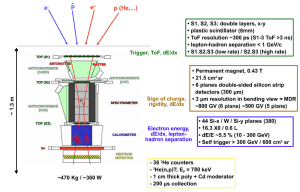 The PAMELA telescope is based on:
The PAMELA telescope is based on:
- A Magnetic Spectrometer, made of neodymion-iron-boron permanent magnet and a precision tracking system.
Charged particles passing through the instrument aperture are deflected by the magnetic field. The resulting curved trajectories provide the electric charge-sign and magnetic rigidity (momentum/charge) of the particles. The sign of the electric charge is determined with a very high confidence degree, and the momentum of the particle is measured up to 1.2 TeV. - A sampling imaging Calorimeter, in which pairs of orthogonal ministrip silicon sensor planes are interleaved with tungsten absorber plates. The energy released by the interacting or annihilating particles is measured and the interaction topology of the particles inside the calorimeter is reconstructed. The imaging calorimeter allows to distinguish antiprotons from electrons and positrons from protons with a separation factor of the order of 105.
- A precise Time Of Flight system, using plastic scintillation detectors, measures the charge of the incident particles and the versus of their flight for albedo rejection. At low energy, the instrument is able to determine the mass of the particles combining the measurements of velocity and rigidity. The coincidence of TOF scintillators provides flight reprogrammable fast trigger to initiating event digitisation and read out.
- An Anticoincidence system, based on plastic scintillation counters, flags events in which particles may have entered through the magnet or have produced in pairs with only one traversing the detector.
- A Neutron Detector, composed of 3He counters and polyethylene neutron moderators , helps to distinguish primary protons and electrons at energies 1011-1013 eV.
- A Bottom Scintillator counter for triggering independently the neutron detector.
- A PAMELA service module including On-Board Data Handling (OBDH), power supply and telemetry system.
